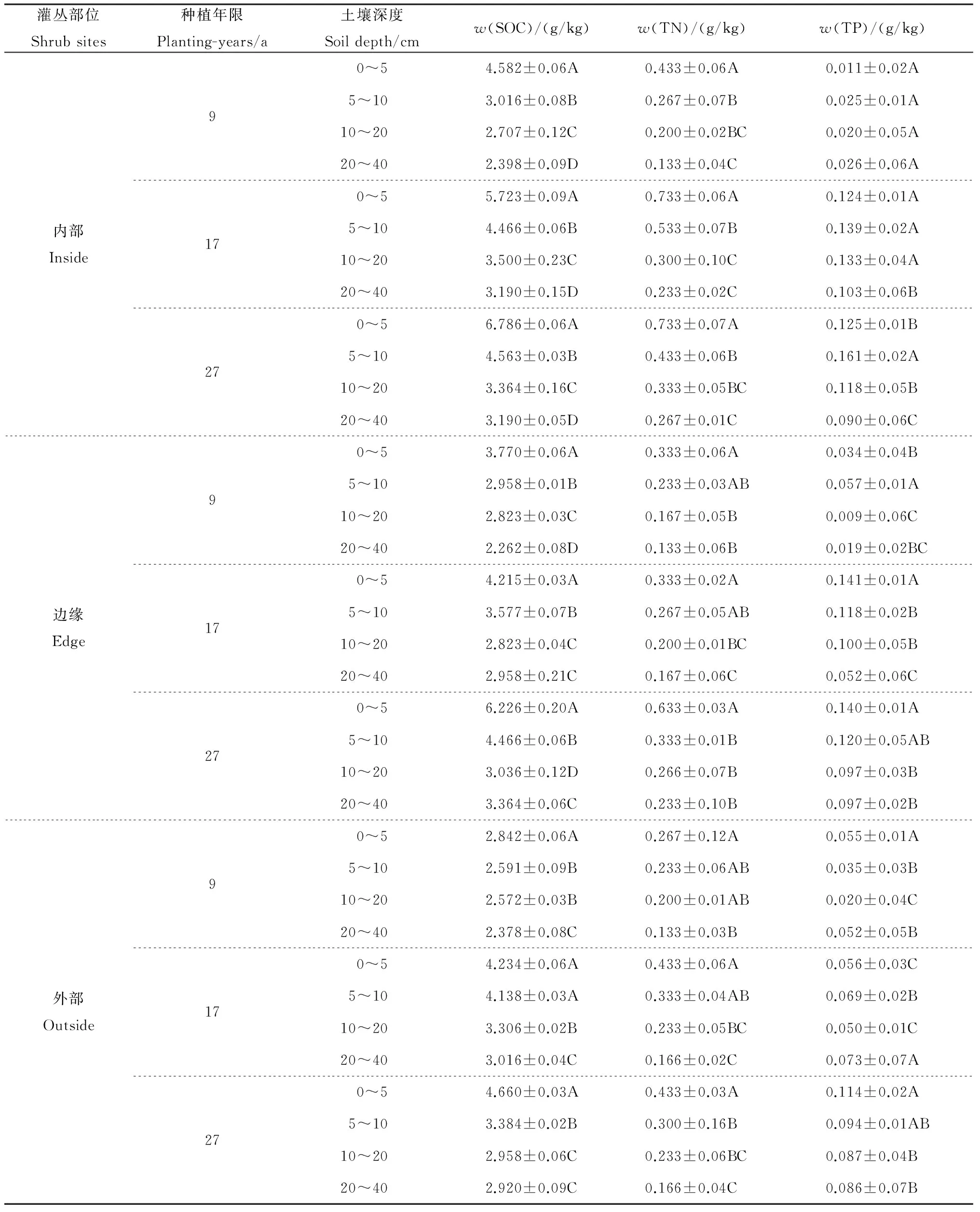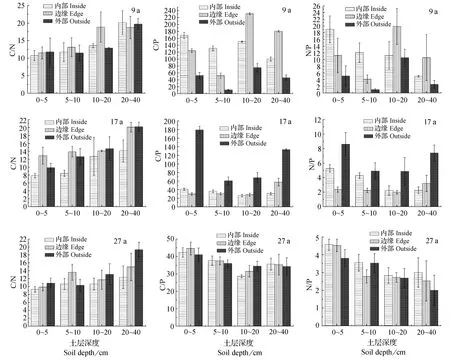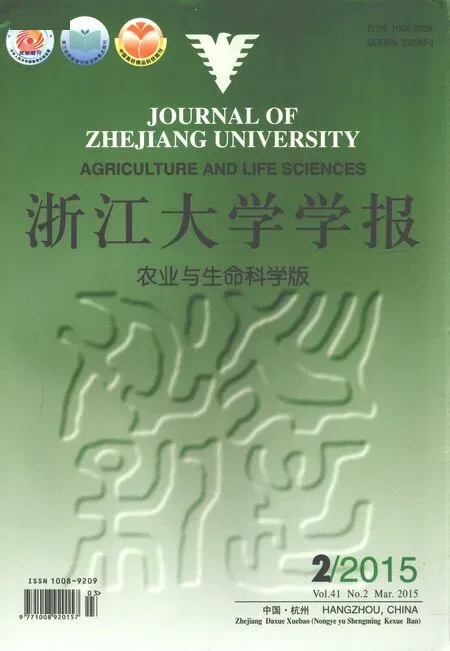荒漠草原不同种植年限人工柠条林土壤碳氮磷化学计量特征
潘军, 宋乃平*, 吴旭东, 杨新国, 陈林, 曲文杰, 翟德苹
(1.宁夏大学西北土地退化与生态恢复国家重点实验室培育基地,银川 750021;2.宁夏大学西部生态与生物资源开发联合研究中心,银川 750021;3.宁夏大学农学院,银川 750021)
荒漠草原不同种植年限人工柠条林土壤碳氮磷化学计量特征
潘军1,2, 宋乃平1,2*, 吴旭东1,3, 杨新国1,2, 陈林1,2, 曲文杰1,2, 翟德苹1,2
(1.宁夏大学西北土地退化与生态恢复国家重点实验室培育基地,银川 750021;2.宁夏大学西部生态与生物资源开发联合研究中心,银川 750021;3.宁夏大学农学院,银川 750021)
以荒漠草原不同林龄(9 a,17 a,27 a)人工柠条林为对象,研究不同土层深度以及柠条灌丛不同部位的土壤有机碳(soil organic carbon,SOC)、全氮(total nitrogen,TN)和全磷(total phosphorus,TP)含量及其生态化学计量特征变化规律.结果表明:不同林龄柠条灌丛各部位SOC和TN含量在垂直剖面上的分布具有统计学上的极显著差异(P<0.01);灌丛各部位SOC、TN含量均随林龄增加逐渐增大,且随土层加深逐渐减小,具有明显的表聚性,灌丛各部位均表现为内部>边缘>外部;随着柠条林龄的增长,灌丛各部位土壤TP含量呈逐渐增加的趋势.随着林龄的增长,灌丛各部位土壤C/N均呈现逐渐降低的趋势;而土壤C/P在灌丛内部和边缘呈现先降低后增加的趋势,而在灌丛外部呈现逐渐增加的趋势;土壤N/P在灌丛内部和外部呈现逐渐增加的趋势,而在灌丛边缘呈现先降低后增加的趋势.随着土层深度的增加,土壤C/N呈逐渐增加的趋势,而C/P和N/P整体上呈先降低后增加的趋势.N/P与TP呈极显著负相关,而与TN和C/P呈极显著正相关.可见,人工柠条林在生长过程中土壤养分呈现明显的表聚性,柠条灌丛出现“肥岛效应”;由于柠条在生长过程中受到诸多因素的影响,还需加强植被与土壤生态系统N/P化学计量特征,土壤N、P养分限制和植被养分适应特征相互关系的研究.
荒漠草原; 人工柠条灌丛; 种植年限; 土壤; 碳氮磷化学计量特征
Summary The thicketization of the shrub has become a common phenomenon in the arid and semi-arid steppe worldwide. TheCaraganaintermediahas been widely used to prevent grassland degradation because of its low transpiration rate, strong resistance and wide adaptability to the environment. The life activity ofC.intermediawas not only restricted by water shortage, but also limited by soil nutrients and environmental stress. This paper revealed the balance and cycle process of soil organic carbon (SOC), total nitrogen (TN) and total phosphorus (TP) in the soil, in which artificial shrub and grass were mixed planting. Therefore, the results can provide basic data for research on the balance and circulation of SOC, TN, TP in the soil of desert grassland ecosystems.
The artificialC.intermediashrubs in different planting-years (9 a, 17 a, 27 a) were taken as research objects, to analyze the contents and the ecological stoichiometry of SOC, TN, TP in the depth of 0-40 cm.
The result showed that the SOC and TN contents of the artificialC.intermediashrubs with different planting-years had significant differences in the vertical section (P<0.01). The contents of SOC and TN in shrubs increased with the planting-years, but decreased with soil depth from 0 to 40 cm, indicating surface accumulation of SOC and TN in the soil. For SOC and TN contents in any part of the shrubs, the order was inside>edge>outside. The contents of TP increased in all the parts of the shrubs with the planting-years, but the soil C/N ratio of each shrub decreased gradually. Furthermore, the soil C/P ratio first decreased and then increased on the edge and the inside of the shrubs, while gradually increased in the outside of the shrubs. The soil N/P ratio in the inside and outside of shrubs both showed increasing trends, and first decreased and then increased in the edge of the shurbs. The soil C/N ratio increased gradually with the increasing soil depth, while the C/P and N/P ratios first decreased and then increased as a whole. The N/P ratio had a significant negative correlation with the TP content (P<0.01), and significant positive correlations with the TN content and the C/P ratio (P<0.01).
In conclusion, the soil nutrients in artificialC.intermediashrubs show a significant surface accumulation and “fertile island” effect. As the growth ofC.intermediashrubs was affected by various factors, further research should be considered on the N/P stoichiometry characteristics of vegetation and soil ecosystem, and the relations between the limiting nutrients of soil N, P and the nutrient adaptability characteristics of vegetation.
生态化学计量学是研究生物系统能量和化学元素平衡的科学[1],是目前研究元素在生物地球化学循环和生态过程中计量关系和规律的综合有效的方法.碳(C)、氮(N)、磷(P)化学计量特征在生态系统中具有重要意义[2].国内外关于植物生态化学计量已展开了大量研究,但多集中于湿地、森林和草地生态系统[3-6],而对干旱的人工荒漠生态系统[7-8]的研究甚少.干旱区植物的生命活动不仅受水分短缺的限制,还受到土壤养分贫瘠以及胁迫环境的限制,其中,土壤养分限制将会对植物叶片中的营养元素含量产生影响[9].从土壤化学计量学角度揭示人工灌草结合的生态系统土壤内部C、N、P平衡和循环过程[8,10],能为我国荒漠草原生态系统土壤养分平衡和循环研究提供基础数据.
荒漠草原是草原向荒漠过渡的旱生化草原生态系统,是旱生性最强的一类草原[11].灌丛因其独特的形态和生理特性,对荒漠草原较为适应,成了这些区域普遍分布的主要群落类型之一[12].草原灌丛化的自然过程和为防风治沙建植的人工灌丛已经成为全球范围干旱、半干旱地区草原普遍发生的现象[13-14].柠条因蒸腾速率低、抗逆性和适应性强等特点已经被广泛用于遏制草地退化[15-16].针对荒漠草原柠条灌丛土壤养分[15,17-18]、物种多样性[19-20]、生态水文及固沙效应[21]方面已经进行了大量研究,但是在柠条林植被恢复及演替过程中对于土壤化学计量特征的报道不多,而且缺乏灌丛空间尺度上的深入研究.本文以不同种植年限的柠条为研究对象,比较不同种植年限柠条灌丛土壤有机碳、全氮和全磷含量,分析不同种植年限柠条林对荒漠草原土壤化学计量特征影响,以及将计量学特征与环境因子进行偶联研究,进而揭示荒漠草原区土壤C、N、P平衡和循环,为荒漠草原可持续发展、环境保护和生态恢复等提供理论依据以及参考资料.
1 研究地区与研究方法
1.1 研究区概况
研究区位于宁夏盐池县杨寨子社(37°43′—37°55′ N,107°21′—107°38′ E),海拔1 300~1 350 m.北部与毛乌素沙地相连,东南部与黄土高原相连,属典型温带大陆性气候,气候特点为干旱少雨,蒸发量大,冬春2季风大沙多.年平均气温8.2 ℃,年平均降水量292 mm且主要集中在7—9月,蒸发量2 710 mm,干燥度3.1,无霜期160 d,≥10 ℃积温2 945 ℃.地带性土壤为灰钙土,非地带性土壤主要是风沙土和盐碱土.
1.2 研究方法
1.2.1 样地选取 于2013年9月上旬在研究区选择行距均为8 m的9 a(2004年种植)、17 a(1996年种植)、27 a(1986年种植)柠条林作为研究对象,分别在研究地点的丘陵坡地中部的坡度平缓地带建立90 m×150 m研究样地,将其划分为30 m×30 m的网格,在每一网格内选取柠条灌丛斑块1丛,共45丛,其形态特征见表1.试验区地势平坦,表层明显沙化,3个样地在空间上相邻,地形、植被及土壤类型基本一致.

表1 研究区柠条形态特征
1.2.2 土壤取样与分析 分别在9 a、17 a、27 a灌丛内部、边缘、外部用剖面法按0~5、5~10、10~20、20~40 cm不同土层取样,各土层3个重复,分层取样后相同层均匀混合,共取180个土样,于室内自然风干,挑去活体根系,研磨过60目筛,采用元素分析仪(Elementar Vario MACRO)测定土壤有机碳(soil organic carbon,SOC)和全氮(total nitrogen,TN)含量,采用高氯酸-硫酸消化,钼锑抗比色法[22](UV-2450)测定全磷(total phosphorus,TP)含量.
1.3 数据统计与分析
数据在 Microsoft Excel 2003软件中进行整理,利用SPSS 19.00软件,采用单因素方差分析(one-way ANOVA)和最小显著差法(least-significant difference, LSD)对数据进行检验,用皮尔逊(Pearson)相关系数判定数据的相关性,同时结合Origin 8.0软件进行制图.
2 结果与分析
2.1 柠条灌丛SOC、TN、TP含量特征
从表2及表3中可以看出,不同林龄柠条灌丛各部位SOC和TN含量在垂直剖面上的分布呈极显著差异(P<0.01).灌丛各部位SOC、TN含量均随林龄增加逐渐增大,且随土层加深逐渐减小,具有明显的表聚性,在剖面上呈现出“倒金字塔”的分布(表2),各部位均表现为内部>边缘>外部(表3).具体表现为灌丛内部SOC质量分数为2.398~6.786 g/kg,灌丛边缘SOC质量分数为2.262~6.226 g/kg,灌丛外部SOC质量分数为2.378~4.660 g/kg;土壤TN在灌丛内外均为17 a时最高,除9 a外,17 a及27 a柠条灌丛内部TN含量极显著高于灌丛外部(P<0.01),可得出柠条灌丛存在明显的“肥岛效应”;土壤TP含量在灌丛内部随着土层深度的增加呈现先增加后减小的趋势,而在灌丛边缘和外部随着土层深度的增加整体上呈现递减的趋势,随着柠条林龄的增长灌丛各部位土壤TP含量呈逐渐增加的趋势,在9 a时柠条灌丛土壤TP含量为外部>边缘>内部,而在17 a和27 a时柠条灌丛土壤TP含量为内部>边缘>外部,随着土层深度的增加,TP含量呈波动性变化,在土壤剖面上表现为“圆柱体”分布模式.
2.2 不同林龄SOC、TN、TP化学计量特征
从表3可知,不同林龄柠条灌丛各部位土壤C/N、C/P和N/P呈现规律性的变化,具体表现为:不同林龄柠条灌丛从内部、边缘到外部其C/N均表现为先增大后减小的变化规律;C/P在 9 a及27 a表现为边缘>外部>内部,而在17 a表现为外部>边缘>内部;N/P在9 a和27 a时从灌丛内部到外部表现为逐渐降低的趋势,而在17 a表现为先减小后增大的规律.另外,随着林龄的增加,灌丛各部位土壤C/N均呈现逐渐降低的趋势;而土壤C/P在灌丛内部和边缘呈现先减小后增加的趋势,而在灌丛外部呈现逐渐增加的趋势;土壤N/P在灌丛内部和外部呈现逐渐增加的趋势,而在灌丛边缘呈现先减小后增加的趋势.9 a柠条灌丛土壤的C∶N∶P (61.87∶4.85∶1)显著高于17 a柠条灌丛土壤的C∶N∶P(41.83∶3.63∶1),同时也高于27 a柠条灌丛土壤的C∶N∶P(36.88∶3.32∶1).

表2 灌丛斑块不同部位的SOC、TN、TP质量分数
SOC:土壤有机碳;TN:全氮;TP:全磷.同列数据后的不同大写字母表示在同一种植年限灌丛的不同土层间在P<0.01水平差异有统计学意义.
SOC: Soil organic carbon; TN: Total nitrogen; TP: Total phosphorus. Different capital letters in the same column indicate significant differences at the different soil layers of the same planting-year shrub at the 0.01 probability level.

表3 不同林龄各部位SOC、TN、TP化学计量特征
SOC:土壤有机碳;TN:全氮;TP:全磷.同列数据后的不同大写字母表示在P<0.01水平差异有统计学意义.
SOC: Soil organic carbon; TN: Total nitrogen; TP: Total phosphorus. Different capital letters in the same column indicate significant differences at the 0.01 probability level.
2.3 不同深度土层SOC、TN、TP化学计量特征
如图1所示:随着土层深度的增加,土壤C/N呈逐渐增加的趋势,而C/P和N/P整体上呈先降低后增加的趋势.随着土层深度的增加,在各年限中土壤C/N在灌丛内部、边缘、外部均呈现逐渐增大的趋势;土壤C/P在各年限灌丛的内部和边缘先降低后增加,而在灌丛外部,9 a和17 a时先降低后升高,在27 a时呈逐渐降低的趋势;各年限土壤N/P在灌丛内部均逐渐降低,而在灌丛边缘和外部在9 a和17 a时先降低后升高,在27 a时呈逐渐降低的趋势.
2.4 SOC、TN、TP含量与化学计量比之间的皮尔逊(Pearson)相关分析
由表4可以看出,研究区SOC与TN含量呈极显著相关(P<0.01).SOC与C/N呈极显著负相关,而与C/P之间呈极显著正相关(P<0.01);TN与C/N和N/P呈极显著正相关(P<0.01);TP与C/N和N/P均呈极显著负相关,而与C/P呈极显著正相关(P<0.01).C/N值与TN的相关性大于与SOC的相关性,表明研究区土壤中C/N值主要受土壤TN的影响;C/P值与SOC的相关性大于与TP的相关性,说明土壤中的C/P值主要受SOC的影响;N/P值与TP呈极显著负相关,而与TN含量呈极显著正相关;C/P与N/P呈极显著正相关.

图1 不同深度土层SOC、TN、TP化学计量特征

表4 SOC、TN、TP含量与化学计量比之间的皮尔逊相关分析
SOC:土壤有机碳;TN:全氮;TP:全磷.**表示在0.01水平(双尾检验)显著相关.
SOC: Soil organic carbon; TN: Total nitrogen; TP: Total phosphorus. **Correlation is significant at the 0.01 probability level (2-tailed).
3 讨论
本研究不同林龄柠条灌丛各部位SOC和TN含量在垂直剖面上的分布具有统计学上的极显著差异(P<0.01).SOC的垂直分布规律是由于根系分布深度及其分泌物不同导致的,柠条灌丛根系入土较深,柠条根系死亡会增加土壤中的有机质,因此SOC在其根系分布密集处含量最高并出现峰值[23-24].此外,柠条灌丛枯枝落叶的分解和矿化也会导致土壤有机质含量提高[25].柠条林地的土壤氮素主要来源于大气氮沉降、根系吸收与有机质分解和根瘤固氮作用的平衡[26],柠条根系的生长改变了土壤TN含量的垂直分布状况,从而使SOC和TN具有明显的表聚性,在剖面上呈现出“倒金字塔”的分布.土壤P素来源相对固定,主要通过岩石的风化.由于岩石风化是一个漫长的过程,风化程度在0~40 cm土壤层中差异不大,这就使得TP在土壤中的垂直分布呈现上下差异不大的“圆柱体”形状,而在灌丛边缘和外部随着土层深度增加呈现递减的趋势,说明土壤微生物垂直方向的固氮作用和养分归还效应高于其根系分布及分泌物等影响[27],同时也说明荒漠草原引入柠条灌丛后改变了土壤可利用碳源和氮源的微生物群落的垂直分布[28],从而导致SOC与TN和TP在土壤垂直方向分布规律表现出一定的偏差.本研究不同林龄柠条灌丛不同部位SOC和TN含量均呈内部>边缘>外部,随着柠条林龄的增长灌丛内部和边缘TP含量逐渐增加,这与其他学者的研究结果[29]一致,通过比较可以得出柠条灌丛存在明显的“肥岛效应”.
碳氮磷比(C/N/P)是土壤有机质或其他成分中的C、N、P总质量的比值,是衡量土壤有机质组成和营养平衡的一个重要指标[29],是确定土壤C、N、P平衡特征的重要参数[30].与全球不同生态系统土壤的平均水平(C∶N∶P=186∶13∶1)[30]相比,本研究不同林龄灌丛柠条的C/N、C/P和N/P均较低.Tian等[31]在对土壤C/N/P的研究中也指出,虽然SOC和TN含量具有较大的空间变异性,但C/N相对稳定,受气候的影响很小.而本研究随着柠条林龄的增长,土壤C/N有降低的趋势,这是由于柠条为豆科灌木,根部有大量可以固定空气中的游离氮素的根瘤菌,从而使土壤含氮量增加[32].土壤C/P比值可作为衡量微生物矿化土壤有机物质释放磷或从环境中吸收固持磷素潜力的一种指标[23].在本研究中随柠条土层深度的增加土壤C/P在各年限灌丛的内部和边缘先降低后增加.研究区土壤的C/P值为46,低于我国平均值(105),表明研究区土壤微生物体有机磷出现了净矿化现象[33].在柠条灌丛0~40 cm土壤中,C/N随着土层深度的增加均呈现逐渐增加的趋势,主要是柠条灌丛氮下降幅度大于碳直接造成的;随着土层深度的增加土壤的C/P在各年限灌丛的内部和边缘先降低后增加,随柠条林龄的增长,土壤C、N、P含量也逐渐增加,而表层C/N和C/P值呈下降趋势,深层土壤C/N和C/P的降低幅度不大,说明在林龄增加过程中,表层SOC的增加导致了N素和P素的增加,在同等程度下表层N素和P素的增加比C素增加更为敏感,而深层土壤C/N和C/P变化幅度并不明显,说明深层土壤中N素和P素的增加与C素增加保持一致.土壤TN、TP状况对植物的影响不仅表现为植物N、P营养失衡作用,也表现在土壤TN、TP含量高低对植物造成的营养贫瘠或毒害作用[34].
本研究柠条灌丛土壤SOC、TN含量呈极显著相关(P<0.01),这一结果与前人的研究结果[35]相似.土壤TP与C/N和N/P均呈现出极显著负相关,而与C/P呈极显著正相关,C/N值与TN的相关性大于与SOC的相关性,表明研究区土壤中C/N值主要受土壤TN的影响;C/P值与SOC的相关性大于与TP的相关性,说明土壤中C/P值主要受土壤SOC的影响;N/P值与TP呈极显著负相关,而与TN含量呈极显著正相关,说明TN增加对N/P有贡献作用。由于在柠条生长过程中土壤养分限制与植物特性差异的相互作用难以区分,如果进一步研究其限制因素,还需对其叶片N和P含量进行综合研究,从而确定柠条灌丛土壤N/P是受N限制还是P限制.
[1] Sterner R W, Elser J J.EcologicalStoichiometry:TheBiologyofElementsfromMoleculestotheBiosphere. Princeton, USA: Princeton University Press, 2002:344-392.
[2] Smith V H. Effects of nitrogen: Phosphorus supply ratios on nitrogen fixation in agricultural and pastoral ecosystems.Biogeochemistry, 1992,18(1):19-35.
[3] Han W X, Fang J Y, Guo D L,etal. Leaf nitrogen and phosphorus stoichiometry across 753 terrestrial plant species in China.NewPhytologist, 2005,168(2):377-385.
[4] 高三平,李俊祥,徐明策,等.天童常绿阔叶林不同演替阶段常见种叶片N、P化学计量学特征.生态学报,2007,27(3):947-952.
Gao S P, Li J X, Xu M C,etal. Leaf N and P stoichiometry of common species in successional stages of the evergreen broad-leaved forest in Tiantong National Forest Park, Zhejiang Province, China.ActaEcologicalSinica, 2007,27(3):947-952. (in Chinese with English abstract)
[5] Duru M, Cruz P P, Raouda A H K,etal. Relevance of plant functional types based on leaf dry matter content for assessing digestibility of native grass species and species-rich grassland communities in spring.AgronomyJournal, 2008,100(6):1622-1630.
[6] 任书杰,于贵瑞,陶波,等.中国东部南北样带 654 种植物叶片氮和磷的化学计量学特征研究.环境科学,2007,28(12):2665-2673.
Ren S J, Yu G R, Tao B,etal. Leaf nitrogen and phosphorus stoichiometry across 654 terrestrial plant species in NSTEC.EnvironmentalScience, 2007,28(12):2665-2673. (in Chinese with English abstract)
[7] 李从娟,雷加强,徐新文,等.塔克拉玛干沙漠腹地人工植被及土壤C、N、P的化学计量特征.生态学报,2013,33(18):5760-5767.
Li C J, Lei J Q, Xu X W,etal. The stoichiometric characteristics of C, N, P for artificial plants and soil in the hinterland of Taklimakan Desert.ActaEcologicalSinica, 2013,33(18):5760-5767. (in Chinese with English abstract)
[8] 李玉霖,毛伟,赵学勇,等.北方典型荒漠及荒漠化地区植物叶片氮磷化学计量特征研究.环境科学,2010,31(8): 1716-1725.
Li Y L, Mao W, Zhao X Y,etal. Leaf nitrogen and phosphorus stoichiometry in typical desert and desertified regions, north China.EnvironmentalScince, 2010,31(8):1716-1725. (in Chinese with English abstract)
[9] Ratnam J, Sankaran M, Hanan N P,etal. Nutrient resorption patterns of plant functional groups in a tropical savanna: Variation and functional significance.Oecologia, 2008,157(1):141-151.
[10] He J S, Fang J Y, Wang Z H,etal. Stoichiometry and large-scale patterns of leaf carbon and nitrogen in the grassland biomes of China.Oecologia, 2006,149(1):115-122.
[11] 吕桂芬,吴永胜,李浩,等.荒漠草原不同退化阶段土壤微生物、土壤养分及酶活性的研究.中国沙漠,2010,30(1):104-109.
Lü G F, Wu Y S, Li H,etal. Microorganisms, soil nutrient and enzyme activity changing with the proceeding of desert steppe degradation in Inner Mongolia.JournalofDesertResearch, 2010,30(1):104-109. (in Chinese with English abstract)
[12] 张宏,史培军,郑秋红.半干旱地区天然草地灌丛化与土壤异质性关系研究进展.植物生态学报,2001,25(3):366-370.
Zhang H, Shi P J, Zheng Q H. Research progress in relationship between shrub invasion and soil heterogeneity in a natural semi-arid grassland.ActaPhytoecologicaSinica, 2001,25(3):366-370. (in Chinese with English abstract)
[13] Grover H D, Musick H B. Shrub land encroachment in Southern New Mexico, USA: Analysis of desertification process in the American Southwest.ClimaticChange, 1990,17:305-330.
[14] Archer S, Stokes C J. Stress, disturbance and change in rangland ecosystems // Arnalda O, Archer S.RangelandDesertification:AdvancesinVegetationScience. Netherlands: Kluwer Press, 2000:17-24.
[15] 宋乃平,杨新国,何秀珍,等.荒漠草原人工柠条林重建的土壤养分效应.水土保持通报,2012,32(4):21-26.
Song N P, Yang X G, He X Z,etal. Soil nutrient effect of desert steppe reconstructed artificialCaraganamicrophyllastand.BulletinofSoilandWaterConservation, 2012,32(4):21-26. (in Chinese with English abstract)
[16] 王孟本,李洪建,柴宝峰.柠条(Caraganakorshinskii)的水分生理生态学特性.植物生态学报,1996,20(6):494-501.
Wang M B, Li H J, Chai B F. Water ecophysiological characteristics ofCaraganakorshinskii.ActaPhytoecologicaSinica, 1996,20(6):494-501. (in Chinese with English abstract)
[17] 安韶山,黄懿梅.黄土丘陵区柠条林改良土壤作用的研究.林业科学,2006,42(1):70-74.
An S S, Huang Y M. Study on the ameliorate benefits ofCaraganakorshinskiishrubwood to soil properties in loess hilly area.ScientiaSilvaeSinicae, 2006,42(1):70-74. (in Chinese with English abstract)
[18] 刘任涛,杨新国,宋乃平,等.荒漠草原区固沙人工柠条林生长过程中土壤性质演变规律.水土保持学报,2012,26(4):108-112.
Liu R T, Yang X G, Song N P,etal. Soil properties following growing artificial forests (Caraganamicrophylla) process of in desert steppe.JournalofSoilandWaterConservation, 2012,26(4):108-112. (in Chinese with English abstract)
[19] 张晶晶,王蕾,许冬梅.荒漠草原自然恢复中植物群落组成及物种多样性.草业科学,2011,28(6):1091-1094.
Zhang J J, Wang L, Xu D M. Composition and plant species diversity of plant community in the process of natural restoration of desert steppe.PrataculturalScience, 2011,28(6):1091-1094. (in Chinese with English abstract)
[20] 杜茜,马琨.宁夏荒漠草原恢复演替过程中物种多样性与生产力的变化.生态环境,2007,16(4):1225-1228.
Du Q, Ma K. Changes of the species diversity and productivity of desert steppe in restoration succession in Ningxia.EcologyandEnvironment, 2007,16(4):1225-1228. (in Chinese with English abstract)
[21] 赵哈林,周瑞莲,赵学勇,等.呼伦贝尔沙质草地土壤理化特性的沙漠化演变规律及机制.草业学报,2012,21(2):1-7.
Zhao H L, Zhou R L, Zhao X Y,etal. Desertification mechanisms and process of soil chemical and physical properties in Hulunbeir sandy grassland, Inner Mongolia.ActaPrataculturaeSinica, 2012,21(2):1-7. (in Chinese with English abstract)
[22] 鲍士旦.土壤农化分析.3版.北京:中国农业出版社,2000:68-70.
Bao S D.SoilAgro-ChemistricalAnalysis. 3rd ed. Beijing: China Agriculture Press, 2000:68-70. (in Chinese)
[23] 朱秋莲,邢肖毅,张宏,等.黄土丘陵沟壑区不同植被区土壤生态化学计量特征.生态学报,2013,33(15):4674-4682.
Zhu Q L, Xing X Y, Zhang H,etal. Soil ecological stoichiometry under different vegetation area on loess hilly-gully region.ActaEcologicalSinica, 2013,33(15):4674-4682. (in Chinese with English abstract)
[24] 张社奇,王国栋,张蕾.黄土高原刺槐林对土壤养分时空分布的影响.水土保持学报,2008,22(5):91-95.
Zhang S Q, Wang G D, Zhang L. Time-space distributive feature of soil nutrient and chemical characteristics ofRobiniapseudoaciaL. plantation forestland in Loess Plateau.JournalofSoilandWaterConservation, 2008,22(5):91-95. (in Chinese with English abstract)
[25] 牛西午,张强,杨治平,等.柠条人工林对晋西北土壤理化性质变化的影响研究.西北植物学报,2003,23(4):628-632.
Niu X W, Zhang Q, Yang Z P,etal. Research on change of soil properties ofCaraganaplantation in North-west of Shanxi Province.ActaBotanicaBoreali-OccidentaliaSinica, 2003,23(4):628-632. (in Chinese with English abstract)
[26] 刘增文,李雅素.黄土丘陵区柠条林地养分状况及其循环规律.生态学杂志,1997,16(6):27-29.
Liu Z W, Li Y S. Fertility and element bio-cyclings of theCaraganamicrophyllaL. forestland in the rolling loess region.ChineseJournalofEcology, 1997,16(6):27-29. (in Chinese with English abstract)
[27] Barnes M S, Forster J C, Keller J H. Electron energy distribution function measurements in a planar inductive oxygen radio frequency glow discharge.AppliedPhysicsLetters, 1993,62(21):2622-2624.
[28] Cabrera M L, Beare M H. Alkaline persulfate oxidation for determining total nitrogen in microbial biomass extracts.SoilScienceSocietyofAmericaJournal, 1993,57(4):1007-1012.
[29] Schlesinger W H, Reynolds J F, Cunningham G L,etal. Biological feedbacks in global desertification.Science, 1990,247:1043-1048.
[30] Cleveland C C, Liptzin D. C∶N∶P stoichiometry in soil: Is there a “Redfield ratio” for the microbial biomass?Biogeochemistry, 2007,85:235-252.
[31] Tian H, Chen G, Zhang C,etal. Pattern and variation of C∶N∶P ratios in China’ s soils: A synthesis of observational data.Biogeochemistry, 2010,98(3):139-151.
[32] 周道玮.锦鸡儿属植物分布研究.植物研究,1996,16(4):428-435.
Zhou D W. Study on distribution of the genusCaraganaFabr.BulletinofBotanicalResearch, 1996,16(4):428-435. (in Chinese with English abstract)
[33] 黄昌勇,李保国,潘根兴,等.土壤学.北京:中国农业出版社,2000:199-225.
Huang C Y, Li B G, Pan G X,etal.SoilScience. Beijing: China Agriculture Press, 2000:199-225. (in Chinese)
[34] 顾大形,陈双林,黄玉清.土壤氮磷对四季竹叶片氮磷化学计量特征和叶绿素含量的影响.植物生态学报,2011,35(12):1219-1225.
Gu D X, Chen S L, Wang Y Q. Effects of soil nitrogen and phosphonium on leaf nitrogen and phosphonium stoichiometric characteristics and chlorophyll content ofOligostachyumlubricum.ChineseJournalofPlantEcology, 2011,35(12):1219-1225. (in Chinese with English abstract)
[35] 刘万德,苏建荣,李帅锋,等.云南普洱季风常绿阔叶林演替系列植物和土壤C、N、P化学计量特征.生态学报,2010,30(23):6581-6590.
Liu W D, Su J R, Li S F,etal. Stoichiometry study of C, N and P in plant and soil at different successional stages of monsoon evergreen broad-leaved forest in Pu’er, Yunnan Province.ActaEcologicaSinica, 2010,30(23):6581-6590. (in Chinese with English abstract)
Effects of different planting-years of artificialCaraganaintermediashrubs on soil organic carbon, nitrogen and phosphorus stoichiometry characteristics in desert steppe. Journal of Zhejiang University (Agric. & Life Sci.), 2015,41(2):160-168
Pan Jun1,2, Song Naiping1,2*, Wu Xudong1,3, Yang Xinguo1,2, Chen Lin1,2, Qu Wenjie1,2, Zhai Deping1,2
(1.BreedingBaseofStateKeyLaboratoryforPreventingLandDegradationandEcologicalRestoration,NingxiaUniversity,Yinchuan750021,China; 2.UnionResearchCenterforEcologyandExploitionofBiologicalResourcesinWesternChina,NingxiaUniversity,Yinchuan750021,China; 3.CollegeofAgriculture,NingxiaUniversity,Yinchuan750021,China)
desert steppe; artificialCaraganaintermediashrubs; planting-years; soil; C, N, P stoichiometry characteristics
国家重点基础研究发展计划(973计划)前期专项(2012CB723206);国家自然科学基金(41461046;31460123;31460161).
联系方式:潘军,E-mail:pj19890101shiyan@163.com
2014-05-04;接受日期(Accepted):2014-09-02;网络出版日期(Published online):2015-03-20
S 154.1; S 812.2
A
*通信作者(Corresponding author):宋乃平,E-mail:songnp@163.com
URL:http://www.cnki.net/kcms/detail/33.1247.S.20150320.2111.012.html

